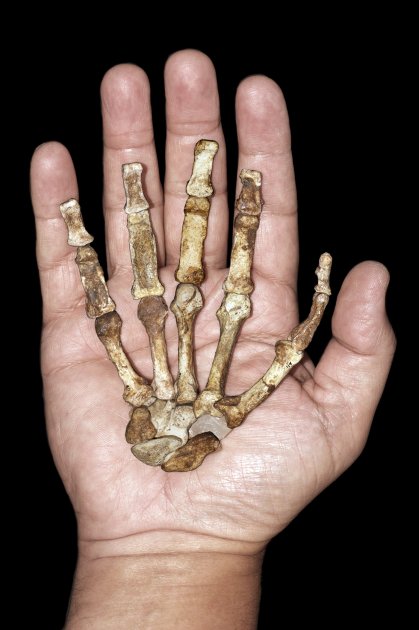A startling mix of human and primitive traits found in the brains, hips, feet and hands of an extinct species identified last year make a strong case for it being the immediate ancestor to the human lineage, scientists have announced.
These new findings could rewrite long-standing theories about the precise steps human evolution took, they added, including the notion that early human female hips changed shape to accommodate larger-brained offspring. There is also new evidence suggesting that this species had the hands of a toolmaker.
Fossils of the extinct hominid known as Australopithecus sediba were accidentally discovered by the 9-year-old son of a scientist in the remains of a cave in South Africa in 2008, findings detailed by researchers last year. Australopithecus means "southern ape," and is a group that includes the iconic fossil Lucy, while sediba means "wellspring" in the South African language Sotho. [See images of human ancestor]
Two key specimens were discovered — a juvenile male as developed as a 10- to 13-year-old human and an adult female maybe in her late 20s or early 30s. The species is both a hominid and a hominin — hominids include humans, chimpanzees, gorillas and their extinct ancestors, while hominins include those species after Homo, the human lineage, split from that of chimpanzees.
To begin to see where Au. sediba might fit on the family tree, researchers pinned down the age of the fossils by dating the calcified sediments surrounding them with advanced uranium-lead dating techniques and a method called paleomagnetic dating, which measures how many times the Earth's magnetic field has reversed. They discovered the fossils were approximately 1.977 million years old, which predates the earliest appearances of traits specific to the human lineage Homo in the fossil record. This places Au. sediba in roughly the same age category as hominids such as Homo habilis and Homo rudolfensis, which were thought to be potential ancestors to Homo erectus, the earliest undisputed predecessor of modern humans. [10 Things That Make Humans Special]
"As the fossil record for early human ancestors increases, the need for more accurate dates is becoming paramount," said researcher Robyn Pickering at the University of Melbourne in Australia.
Small but humanlike brain
Most aspects of Au. sediba display an intriguing mix of both human and more primitive features that hint it might be an intermediary form between Australopithecus and Homo.
"The fossils demonstrate a surprisingly advanced but small brain, a very evolved hand with a long thumb like a human's, a very modern pelvis, but a foot and ankle shape never seen in any hominin species that combines features of both apes and humans in one anatomical package," said researcher Lee Berger, a paleoanthropologist at the University of Witwatersrand in Johannesburg, South Africa. "The many very advanced features found in the brain and body and the earlier date make it possibly the best candidate ancestor for our genus, the genus Homo, more so than previous discoveries such as Homo habilis."
The brain is often thought of as what distinguishes humanity from the rest of the animal kingdom, and the juvenile specimen of Au. sediba had an exceptionally well-preserved skull that could shed light on the pace of brain evolution in early hominins. To find out more, the researchers scanned the space in the skull where its brain would have been using the European Synchrotron Radiation Facility in Grenoble, France; the result is the most accurate scan ever produced for an early human ancestor, with a level of detail of up to 90 microns, or just below the size of a human hair.
The scan revealed Au. sediba had a much smaller brain than seen in human species, with an adult version maybe only as large as a medium-size grapefruit. However, it was humanlike in several ways — for instance, its orbitofrontal region directly behind the eyes apparently expanded in ways that make it more like a human's frontal lobe in shape. This area is linked in humans with higher mental functions such as multitasking, an ability that may contribute to human capacities for long-term planning and innovative behavior.
"We could be seeing the beginnings of those capabilities," researcher Kristian Carlson at the University of Witwatersrand told LiveScience.
These new findings cast doubt on the long-standing theory that brains gradually increased in size and complexity from Australopithecus to Homo. Instead, their findings corroborate an alternative idea — that Australopithecus brains did increase in complexity gradually, becoming more like Homo, and later increased in size relatively quickly.
Read more at Yahoo! News

No comments:
Post a Comment